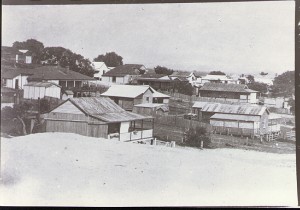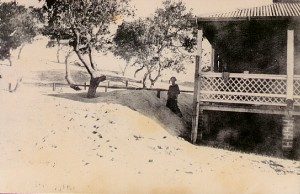

|

The William
Ager Story: Narrators: Marjory Innes, Dorothy Collins Transcription: Marea Buist, 2001 Note: Audio quality is unavoidably poor |
We (The Port of Yamba Historical Society) are presently engaged in recording the reminiscences of many old identities of the district, a district very different to the one seen by William Ager who stabilized the sand dunes. This is story of how a town was saved by the efforts of one man. William Ager, a man ahead of his time in many ways. Ager was born in Mossvale in 1882 one of nine children, whose father was a baker in the district. At the age of twenty he moved to the Clarence Valley with a brother and bought a farm, Trafalgah out at Copmanhurst and there he experimented growing various kinds of citrus fruit and he also kept bees. Ill health forced his early retirement at the age of 45 and he took up residence in the Ritz Boarding House overlooking the beach in Yamba. His life's work was still ahead of him.
At that time the little coastal village of Yamba was slowly being engulfed by the wind blown sands from the east. The Department of Public Works had made an attempt to halt this drift by using corrugated iron sheets staked either side. This did not deflect the wind. It only succeeded in driving the sand underneath the iron. Encroaching sand was dangerously close to engulfing the Ritz and this was a great concern to Mr Ager as he had a financial interest there. So when he saw the problem ahead he put his inventive mind to work and came up with an idea that conservationists and foresters in Europe had been working on and that is to deflect sand by funneling wind flow. To do this Ager used fencing wire, hessian, and canvas in flag like shapes changing the air directions as the wind changed. Getting up at all hours of the night to do this.
The sand cleared around Clarence and Ocean Streets and the Ritz. During the lengthily process of stabilizing the dunes Mr Ager acquired a large area of land which he then began selling. He kept some of the land however and built several houses on it to prove to the sceptical townsfolk that the land was now firm. A house was bought by trailer and erected on reclaimed land in Clarence Street past Ross McQueen's house. An old presbytery was bought from Cowper the same way and two more houses built from that.
In 1941 a
fourth house was built from scratch. Mr Mick Moy now an energetic auctioneer
in Grafton was a lad of 16 of the time and was jack-of-all-trades to Mr
Ager. He speaks glowingly of the standard of careful workmanship, which
Mr Ager insisted upon. This is evident in the fact that the transferred houses and also the fourth
house built on site are still standing. The latter is currently the property
of Mr Austin who has made some additions and alterations.
This is evident in the fact that the transferred houses and also the fourth
house built on site are still standing. The latter is currently the property
of Mr Austin who has made some additions and alterations.
In 1944 Mrs Walton who lives in Clarence Street use to give Mr Ager morning tea each day when he did his rounds each day noticed that his health was failing and persuaded him to call a doctor. He was admitted to Grafton Hospital where he died a week later at the age of 62. Unmarried and with no family to carry on this work. A sad fact in itself because he was apparently extremely fond of children. He was a remarkable man and was undoubtedly responsible for saving the town of Yamba.
As a tribute to his memory we have decided to tell you his story using excerpts from a radio play Once Upon a Sandhill that was written by Barbara Woodwood and was broadcast on the ABC...
ONCE UPON A SANDHILL
NARR: The sandhills of my youth were at a small seaside settlement on the north coast of New South Wales, at the mouth of the Clarence River. Yamba was the name of the village. Yamba and the sandhills where the children played, when I was one of the children.
SMALL BOY 1: And when we've all climbed the sandhill we'll have a race to see who can slide to the bottom quickest.
SMALL BOY 2: Bet I do!
SMALL BOY 1: Bet you don't.
SMALL GIRL 1: Let's slide down the other side, onto the beach. That's steepest.
SMALL BOY 1: There's rocks at the bottom. This side's best.
NARR: And when even the smallest and weakest of us had puffed to the top, the sandhills stretched for a children's eternity - about a quarter of a mile. Before us, we could see the sea. On two sides of the sandhills we would find beaches and sea, and on the fourth, a mangrove swamp. One of the beaches was a sandy linking of two tumblings of rock. The other stretched for four white miles. It was known as Pippi Beach. Originally, they say, thick scrub grew behind Pippi Beach. Then men came, with their cattle, and made tracks through the scrub from the beach. Wind blew sand along the tracks, the sand buried the scrub, the sandhills grew. And how splendid they were to play on, when I was one of the children. But something ugly broke in on our idyll. And this was ugly, this made us afraid.
SMALL GIRL 1: Look!
SMALL BOY 2: What is it?
SMALL GIRL 2: What is it?
SMALL GIRL 1: Look!
SMALL BOY 1: It's a chimney!
SMALL BOY 2: A part of a roof!
SMALL BOY 1: It's a house!
SMALL GIRL 1: A half-buried house!
 NARR:
This was something we couldn't place. Houses were firm, safe, sacred.
We struggled round the edge of the sandhills and found two other houses,
one almost completely buried, one with sand banked up against its walls.
NARR:
This was something we couldn't place. Houses were firm, safe, sacred.
We struggled round the edge of the sandhills and found two other houses,
one almost completely buried, one with sand banked up against its walls.
NARR: Out on the sandhills after dark that night, a ragged man suddenly took shape from the darkness and seized my brother by the arm.
AGER: Yer see them sandhills? Growin' all the time, ain't they? They're not gonna grow any more! I'm gonna stop them!
NARR: No-one knows quite how the idea came to Ager. Certainly the sandhills loomed large in everybody's minds. They towered above the tiny cottages, white, menacing, immense. They threatened the boarding house where he lived. Perhaps the idea first came to him one day when he and his one real friend sat on top of the sandhill close together.
AGER: Look. Look at that'. Jest in the time we've been sittin' here, the wind's scooped out a gully between us. Yer know if the wind moves sand as easy as that a man could move these sandhills!
 NARR:
Yes, no-one knows how he first hit on the method he used to stop the encroaching
sand but the amazing thing is that he devised a method which has been
found most successful all over the world, in America, England, France,
Denmark, Holland, South Africa, Palestine, of first stopping the sand
drift in from the ocean by using the wind to form a dune; and then clothing
the dune with grass; and then grassing the slopes behind. He experimented
with Marram Grass and found it ideal. The extraordinary thing about Marram
Grass is that it can only live in a region of drifting sand. By the time
the Marram Grass had made firm the Yamba sandhills and begun accordingly
to die out, William Ager had other grasses grow in between. Also the brushwood
that he dragged behind every row of grass seeds to protect it, took root
and added the green stuff on the sandhills. No-one knows how Ager first
heard of Marram Grass. What is remarkable is that a man with little education
but with an insatiable thirst for knowledge could so determinately put
his self-acquired knowledge into practice. Over the years he worked tirelessly
and could be seen at all hours of the day or night moving his windbreaks
as the wind changed. He was regarded by the towns people as an eccentric,
and by the children as "Mad Ager".
NARR:
Yes, no-one knows how he first hit on the method he used to stop the encroaching
sand but the amazing thing is that he devised a method which has been
found most successful all over the world, in America, England, France,
Denmark, Holland, South Africa, Palestine, of first stopping the sand
drift in from the ocean by using the wind to form a dune; and then clothing
the dune with grass; and then grassing the slopes behind. He experimented
with Marram Grass and found it ideal. The extraordinary thing about Marram
Grass is that it can only live in a region of drifting sand. By the time
the Marram Grass had made firm the Yamba sandhills and begun accordingly
to die out, William Ager had other grasses grow in between. Also the brushwood
that he dragged behind every row of grass seeds to protect it, took root
and added the green stuff on the sandhills. No-one knows how Ager first
heard of Marram Grass. What is remarkable is that a man with little education
but with an insatiable thirst for knowledge could so determinately put
his self-acquired knowledge into practice. Over the years he worked tirelessly
and could be seen at all hours of the day or night moving his windbreaks
as the wind changed. He was regarded by the towns people as an eccentric,
and by the children as "Mad Ager".
NARR: Even the happiest children grow up. After twenty years we returned to see again the sandhills of our youth. But where there had been a bare, towering, glaring white sandhill, there rose a grassy slope, crusted with houses like a rock with shells.
VOICE 1: Look! Look! There's a hundred feet shaved off the top of the sandhill!
NARR: Ager shaved it off, and tumbled it into the swamp!
VOICE 1: But look! There's a road over the sandhill!
NARR: Ager paid to survey and build that road.
VOICE 1: And houses! Look at the houses, built on shifting sand.
NARR: Ager bound that sand together.
VOICE 1: Houses! Look at all the houses.
 NARR:
Dozens of houses, modern seaside houses, festive, designed for relaxing,
gay with paint, with plate glass windows facing the sea. Blocks of flats,
hot and cold water. Large cars moving easily where Ager dragged pigface
with his bare hands, his heart jumpin' about with the sheer effort. The
sandhill was transformed into a whole new village.
NARR:
Dozens of houses, modern seaside houses, festive, designed for relaxing,
gay with paint, with plate glass windows facing the sea. Blocks of flats,
hot and cold water. Large cars moving easily where Ager dragged pigface
with his bare hands, his heart jumpin' about with the sheer effort. The
sandhill was transformed into a whole new village.
NARR: There's no doubt about it, old Ager saved Yamba. In memory of this remarkable man a park bearing his name was established on land which he donated to the CWA for this purpose. The Park is built on the reclaimed sandhills and is for the use and pleasure of children forever.